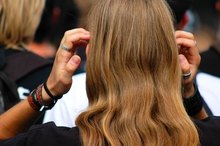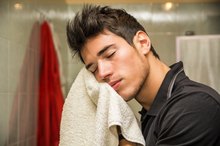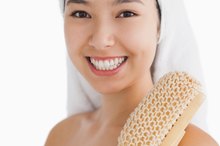What is the Function of Human Hair?
Compared with other primates, humans have very little hair on their bodies. However, what hair we do have serves various important functions, depending on its location. Hair collects sweat and protects us from damaging sun rays and from particles of debris and foreign objects that could hurt the skin or enter the body.
History
At one time, anthropologists tell us, humans had a protective coating of hair over their entire bodies that helped regulate body temperature and protect their skin from the sun. That was back when, like other primates, we walked around naked, on all fours, and more of our skin was directly exposed to ultraviolet rays than it is today. As we evolved to a standing position, we no longer needed hair everywhere, and experts at the Smithsonian Institute believe this was probably when we began to lose most of it 1. Although we maintain the same number of hair follicles as apes, most of the hair on our bodies is comparatively fine in texture.
- At one time, anthropologists tell us, humans had a protective coating of hair over their entire bodies that helped regulate body temperature and protect their skin from the sun.
- That was back when, like other primates, we walked around naked, on all fours, and more of our skin was directly exposed to ultraviolet rays than it is today.
Types
How Long Does it Take for Hair to Grow?
Learn More
In addition to head hair and the light coating of fine hair that covers our arms, legs and faces and lines our nostrils and ear canals, humans also grow hair in the pubic and axillary (underarm) areas. Pubic hair and axillary hair are hormone-induced, secondary sex characteristics that develop during puberty in both men and women. Facial hair is also a secondary sex characteristic in men that results from testosterone production. Hair types and amounts vary from person to person and with age, race and individual genetic patterns.
- In addition to head hair and the light coating of fine hair that covers our arms, legs and faces and lines our nostrils and ear canals, humans also grow hair in the pubic and axillary (underarm) areas.
- Pubic hair and axillary hair are hormone-induced, secondary sex characteristics that develop during puberty in both men and women.
Function
The location of hair general indicates its role. Head hair protects the scalp against the burning sun and helps hold in body heat. Eyelashes and eyebrow hair help keep foreign matter out of the eyes, and hair in the nostrils and ear canal help catch dust, debris and even insects from entering the body. Nostril hair also helps regulate the temperature of inhaled air before it enters the body. Human body hairs are connected to touch receptors in the skin that allow us to feel and, in that sense, collectively serve as a protective warning device.
- The location of hair general indicates its role.
- Eyelashes and eyebrow hair help keep foreign matter out of the eyes, and hair in the nostrils and ear canal help catch dust, debris and even insects from entering the body.
Features
How to Remove Chlorine From Hair Naturally
Learn More
Hair also serves the aesthetic function of adding beauty to the human body. Head hair frames the face just as eyebrows frame the eyes. Hairstyles often serve as a form of individual expression. Facial hair helps differentiate men from women, and pubic hair indicates that a man or woman has reached puberty and is becoming sexually mature and ready to reproduce.
- Hair also serves the aesthetic function of adding beauty to the human body.
Theories/Speculation
In many cases, experts can only speculate as to specialized functions of human hair on different parts of the body. Such is the case with pubic hair, which experts at the University of California say may function as a trap for pheromones, the odors produced by the genitals that stimulate sexual behavior 3.
Related Articles
References
- Smithsonian Institute: What Does it Mean to be Human: Why and How Long Ago Did we Lose our Body Hair?
- Functions of Hair in Chemical and Physical Behavior of Human Hair, 4th Ed; Clarence R. Robbins; 2002
- University of California Santa Barbara: Sex Info: The Hair Down There
- American Society of Clinical Oncology. Hair loss of alopecia. Updated August, 2018.
- Saed S, Ibrahim O, Bergfeld WF. Hair camouflage: A comprehensive review. Int J Womens Dermatol. 2017;3(1 Suppl):S75–S80. Published 2017 Feb 16. doi:10.1016/j.ijwd.2017.02.016
- Dua P, Heiland MF, Kracen AC, Deshields TL. Cancer-related hair loss: a selective review of the alopecia research literature. Psychooncology. 2017;26(4):438-443. doi:10.1002/pon.4039
- National Cancer Institute. Hair loss (alopecia) and cancer treatment. Updated January 15, 2020.
Writer Bio
Molly McAdams is a writer who lives in New York City. She has covered health and lifestyle for various print and online publishers since 1989. She holds a Master of Science degree in nutrition.









